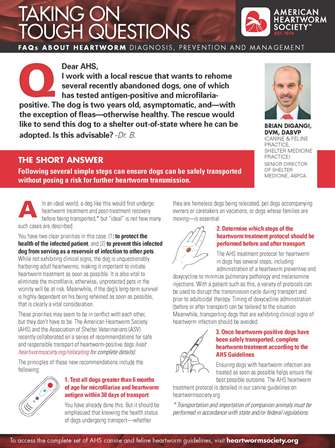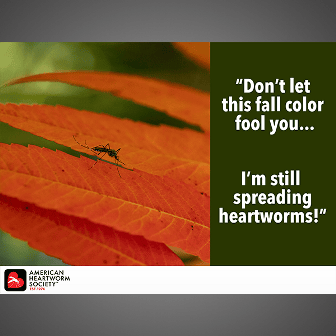Brian DGangi, DVM, DABVP (Canine & Feline Practice, Shelter Medicine Practice)
Senior Director Of Shelter Medicine, ASPCA
Dear AHS,
I work with a local rescue that wants to rehome several recently abandoned dogs, one of which has tested antigen-positive and microfilaria-positive. The dog is two years old, asymptomatic, and—with the exception of fleas—otherwise healthy. The rescue would like to send this dog to a shelter out-of-state where he can be adopted. Is this advisable? -Dr. B.
THE SHORT ANSWER
Following several simple steps can ensure dogs can be safely transported without posing a risk for further heartworm transmission.
A. In an ideal world, a dog like this would first undergo heartworm treatment and post-treatment recovery before being transported,* but “ideal” is not how many such cases are described.
You have two clear priorities in this case: (1) to protect the health of the infected patient; and (2) to prevent this infected dog from serving as a reservoir of infection to other pets. While not exhibiting clinical signs, the dog is unquestionably harboring adult heartworms, making it important to initiate heartworm treatment as soon as possible. It is also vital to eliminate the microfilaria; otherwise, unprotected pets in the vicinity will be at risk. Meanwhile, if the dog’s long-term survival is highly dependent on his being rehomed as soon as possible, that is clearly a vital consideration.
These priorities may seem to be in conflict with each other, but they don’t have to be. The American Heartworm Society (AHS) and the Association of Shelter Veterinarians (ASV) recently collaborated on a series of recommendations for safe and responsible transport of heartworm-positive dogs (visit heartwormsociety.org/relocating for complete details).
The principles of these new recommendations include the following:
- Test all dogs greater than 6 months of age for microfilariae and heartworm antigen within 30 days of transport. You have already done this. But it should be emphasized that knowing the health status of dogs undergoing transport—whether they are homeless dogs being relocated, pet dogs accompanying owners or caretakers on vacations, or dogs whose families are moving—is essential.
- Determine which steps of the heartworm treatment protocol should be performed before and after transport. The AHS treatment protocol for heartwormin dogs has several steps, including administration of a heartworm preventive and doxycycline to minimize pulmonary pathology and melarsomine injections. With a patient such as this, a variety of protocols can be used to disrupt the transmission cycle during transport and prior to adulticidal therapy. Timing of doxycycline administration (before or after transport) can be tailored to the situation. Meanwhile, transporting dogs that are exhibiting clinical signs of heartworm infection should be avoided.
- Once heartworm-positive dogs have been safely transported, complete heartworm treatment according to the AHS Guidelines. Ensuring dogs with heartworm infection are treated as soon as possible helps ensure the best possible outcome. The AHS heartworm treatment protocol is detailed in our canine guidelines on heartwormsociety.org.
* Transportation and importation of companion animals must be performed in accordance with state and/or federal regulations.







